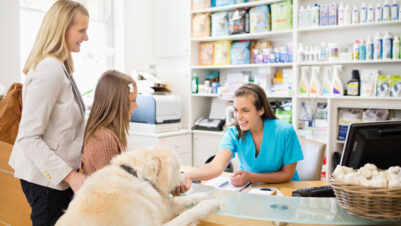
There is a lot of information surrounding the care and consideration that should be taken with cats coming into the veterinary practice to ensure their experience is as stress-free as possible. However, I have found that veterinary receptionists can often forget that these considerations could and should apply to dogs too.
There are many suggestions in the industry about how to create a dog friendly clinic, but after attending the BVRA Congress 2022 and listening to a lecture from the Dogs Trust on dog friendly clinics, a few things resonated with me. As a veterinary receptionist, I have found their advice to be extremely useful and have been able to put it into practice when interacting with dogs in the waiting area.
Let the dog initiate contact and remain aware
One of the things I now advise all veterinary receptionists is to be aware of approaching any dog in the waiting area. It is easy to think that approaching a dog to give it some fuss or attention is going to encourage a positive experience when visiting the practice. Though this is true for some dogs, it is unfortunately not the case for all.
Just because a dog is not showing any negative behaviour towards you, it does not mean that they are enjoying the interaction
Dogs can show their anxiety in a variety of ways; this can be in the form of aggression such as growling, barking, or lunging, but they can also be incredibly quiet and withdrawn and like to hide away. It is important to remember that just because a dog is not showing any negative behaviour towards you, it does not mean that they are enjoying the interaction. Approaching a nervous dog, even with a treat in hand, could cause more stress and trigger a potentially already nervous dog to become overstimulated, which in turn makes the vet or nurse’s job more difficult when they go into the consulting room. I would recommend not approaching a dog in the waiting room unless they initiate contact, but also remember that the dog can change its mind, and what started as a positive interaction can quickly change. Therefore, receptionists should always stay vigilant when interacting with dogs, even those that they know well.
Manage the vocal dog
Working on the reception desk, receptionists have a responsibility to manage the waiting area, which at times may include an owner with a very vocal dog. In my experience, one vocal dog can cause heightened anxiety in others, not only in the waiting area, but also in the consulting rooms. This can startle the animal being examined and make the vet’s assessment of that animal more challenging. It is beneficial in this situation to politely ask a client with a vocal dog to wait outside to avoid any distress to the other animals, as well as potentially helping the dog to feel less anxious itself while waiting. Alternatively, I would try to find an empty consultation room to place the owner and dog in while they wait, in the hope this would make the vocal dog calmer.
Offer advice to the owner
I will try to gently advise the client of more efficient ways to help their pet and explain that these behaviours are normal for dogs that are outside of their comfort zone
I have also become more aware of the way clients are interacting with their dogs when in the waiting area and have been trying to provide them with some advice and guidance on helping their dogs to remain calm. I have witnessed many clients punishing their dogs for their “undesired” behaviour caused by nervous or anxious feelings, including shouting at them and pulling at their lead. I will try to gently advise the client of more efficient ways to help their pet and explain that these behaviours are normal for dogs that are outside of their comfort zone.
Awareness of behaviour
It is always a good idea to make new receptionists aware of both dog and cat behaviour in the waiting room during their training. It is a natural instinct for animal lovers to want to approach a dog to give them a fuss and some (well-deserved!) attention, but we really need to be conscious that we may be putting our desires before the dog’s welfare.









